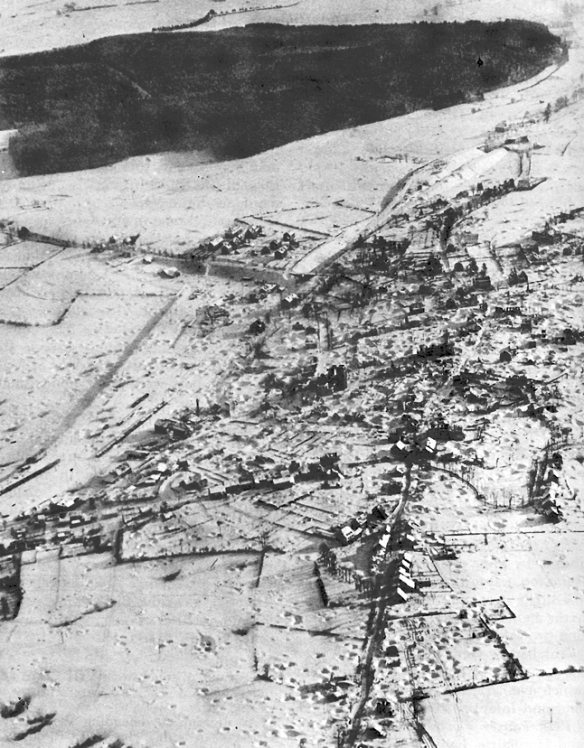St. Vith, Belgium
In the opening phases of the Ardennes offensive, the German L.XVI Korps of General Hasso von Manteuffel’s Fifth Panzer Army had the mission of capturing St. Vith. In the process of doing so, the LXVYI Korps’ 18th and 62nd Volksgrenadier Divisions were supposed to cut off the U.S. 106th Infantry Division in the Schnee Eifel and destroy it. The final capture of the town would then be accomplished by the Fifth Panzer Army’s two Panzer Korps.
The possession of St. Vith was important for the Germans. The town sat at one of the major crossroads through the Ardennes, and astride a major east-west rail line. Thus, the city was supposed to serve as a major transit point for the Fifth Panzer Army. Possession of that key node on the road network to Antwerp would also help SS-Oberstgruppenfuhrer Josef Dietrich’s Sixth Panzer Army, which formed the right wing and main effort of the Ardennes offensive.
The attacking elements for the German divisions were organized into small Stosstrupps and storm companies. The soldiers of these Volksgrenadier divisions, however, were not experienced fighters. For the most part, they were members of the navy and air force, without infantry training. The green U.S. 106th Infantry Division had similar problems. Two of their infantry regiments, the 422th and 423rd, had landed in Normandy only two weeks earlier. They were supposed to be placed in a “quiet sector” to let them get used to combat operations.
At 0400 hours on 16 December 1944, the Stosstrupps of the 18th and 62nd Volksgrenadier Divisions started to infiltrate the American positions. The 18 th Volksgrenadier Division was able to accomplish its missions, but the 62nd Volksgrenadier Division failed on 16 and 17 December. Both units sustained heavy losses in the forest fighting. The delays caused the German operations schedule to slip, which in turn caused coordination problems between the two Panzer Korps.
To expedite the capture of St. Vitn, the LXVI Korps was augmented by the well-equipped Führer-Begleit-Brigade (Hitler’s Escort Brigade). With their help, the attack was resumed on the afternoon of 19 December. That effort stalled too, because of traffic chaos on the few narrow and steep roads, which were also being used by units not involved in the St. Vith attack.
On 16 December, Major General Troy Middleton , commander of the U.S. VIII Corps, ordered the 7th Armored Division to move Irom its reserve position close to Heerlen, the Netherlands, toward Bastogne. Middleton then changed his mind and turned the division toward St. Vith to support the 106th Infantry Division. The 7th Armored Division had to move about 100 kilometers over icy and crowded roads. Elements of the divisions Combat Command B (iCCB), commanded by Brigadier General Bruce C. Clarke , reached St. Vith late on 17 December.
On 20 December, the LXVI Korps finally managed to get control of its units In time and space. Working together, the 62nd Volksgrenadier Division and the Escort Brigade started to make major inroads into the American positions. The 106th Infantry Division was completely encircled, and the LXVI Korps captured over 8,000 American prisoners, along with their weapons, ammunition, food, vehicles, and supplies. Those troops of the 106th Infantry Division who avoided capture made their way to St. Vith and joined the 7th Armored Division.
After its arrival, the 7th Armored Division was faced with constant attacks from the Germans, who were searching for a weak point to break through. Meanwhile, the holdup at St. Vith was starting to cause serious problems for the Sixth Panzer Army, whose supply trains were stuck east of the city in the Eifel. Dietrich, therefore, sent the II SS Panzer Korps south to take St. Vith. The American defense was overcome by the combined pressure of the LXVI Korps and the II SS Panzer Korps.
Faced with the overwhelming superiority of the Germans, Clarke moved the American forces out of the city shortly before midnight on 21 December. The heavy frost settling in that night turned muddy paths into solid roads, which helped the retreat. St. Vith was occupied that night by the 18th Volksgrenadier Division. The Americans, however, conducted such a skilled delaying withdrawal that the Germans made little additional headway that day.
The fight for St. Vith delayed the advance of the right wing of the Fifth Panzer Amy and the left wing of the Sixth Panzer Army for so long that it was a major factor in the Germans losing the race to the Meuse River. The entire time schedule of the Ardennes offensive was disrupted, and that destroyed the surprise factor upon which the whole operation was based. The 7th Armored Division also was fortunate in that it operated almost exactly on the boundary between the two German Panzer Armies, which caused coordination problems for the Germans.
The fighting delay of the American units as they slowly withdrew from St. Vith was a success. Holding St. Vith for as long as they did delayed the Germans, but it was not the only reason for the failure of the Ardennes offensive and the race to the Meuse. Other significant factors included the difficult terrain, the winter weather, the lack of fuel, and Allied air superiority—particularly after the weather cleared on 24 December.
Additional Reading
Cole, Hugh M., The Ardennes: Battle of the Bulge (1965).
Dupuy, R. Ernst, St. Vith: Lion in the Way (1949).
Dupuy, Trevor N., David L. Bongard, and Richard C. Anderson, Jr., Hitler’s Last Gamble: The Battle of the Bulge, December 1944-January 1945 (1995).
Eisenhower, John S.D., The Bitter Woods (1969).
Jung, H., Die Ardennenojfensive 1944/45 (1971).
MacDonald, Charles B., A Time for Trumpets: The Untold Story of the Battle of the Bulge (1985).
